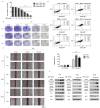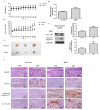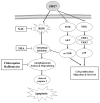JI017 Induces Cell Autophagy and Apoptosis via Elevated Levels of Reactive Oxygen Species in Human Lung Cancer Cells
- PMID: 37108692
- PMCID: PMC10145189
- DOI: 10.3390/ijms24087528
JI017 Induces Cell Autophagy and Apoptosis via Elevated Levels of Reactive Oxygen Species in Human Lung Cancer Cells
Abstract
Lung cancer is one of the most common malignant tumors and a leading cause of cancer-related death in the worldwide. Various anticancer drugs, such as cisplatin and pemetrexed, have been developed for lung cancer treatment but due their drug resistance and side effects, novel treatments need to be developed. In this study, the efficacy of the natural drug JI017, which is known to have few side effects, was tested in lung cancer cells. JI017 inhibited A549, H460, and H1299 cell proliferation. JI017 induced apoptosis, regulated apoptotic molecules, and inhibited colony formation. Additionally, JI017 increased intracellular ROS generation. JI017 downregulated PI3K, AKT, and mTOR expression. JI017 increased the cytosolic accumulation of LC3. We found that JI017 promoted apoptosis through ROS-induced autophagy. Additionally, the xenograft tumor size was smaller in JI017-treated mice. We found that JI017 treatment increased MDA concentrations, decreased Ki-67 protein levels, and increased cleaved caspase-3 and LC3 levels in vivo. JI017 decreased cell proliferation and increased apoptosis by inducing autophagy signaling in H460 and H1299 lung cancer cells. Targeting JI017 and autophagy signaling could be useful in lung cancer treatment.
Keywords: JI017; ROS; autophagy; lung cancer.
Conflict of interest statement
The authors declare no conflict of interest.
Figures






References
-
- Jonna S., Subramaniam D.S. Molecular diagnostics and targeted therapies in non-small cell lung cancer (NSCLC): An update. Discov. Med. 2019;27:167–170. - PubMed
MeSH terms
Substances
Grants and funding
LinkOut - more resources
Full Text Sources
Medical
Research Materials
Miscellaneous

